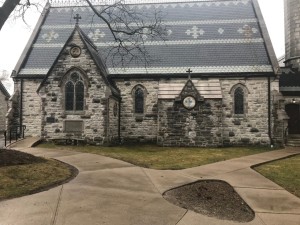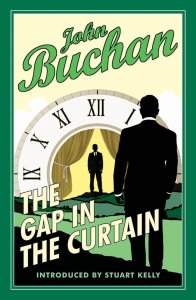


I’m a fan of The Gap in the Curtain, a 1932 novel by the Scottish author John Buchan, the 1st Baron Tweedsmuir, who served as Governor General of Canada between 1935 and 1940. It is a novel about the thinning of the veil at certain times between the worlds of the living and the dead. As an aside, my favourite G.K. Chesterton quote, taken from his 1908 book Orthodoxy, which he described as a “spiritual autobiography,” is “Tradition is the democracy of the dead. It means giving a vote to the most obscure of all classes: our ancestors.”
My supernatural story of the thinning of the veil involves the late Rhonda Payne; a story involving an obscure fridge magnet, of all things, and stretching from Halifax to Yellowknife. Rhonda, author of the play Stars in the Sky Morning, a tale of the hardships of women on the Northern Peninsula of Newfoundland – a playwright the National Post described as a “national treasure” in 1999 – was a fiery actor, writer, director, producer and activist from Curling, Newfoundland, who would go onto co-found Ground Zero Productions with Don Bouzek in Toronto, and after that Riverbank Productions in Peterborough on Parkhill Road East (the studio office was quite literally on the banks of the Otonabee River.) She died in Halifax in June 2002. No saints or miracles in my story, but an experience 20 years ago that sent a chill up my spine like I’ve never felt before.
In late June 2002, I was living in Yellowknife. Rhonda had died in early June at the tragically young age of 52 in Halifax, where she had been living since 2000. She had been ill only a short time.
I had known Rhonda since November 1997 when she lived on Parkhill Road East in Peterborough and she was running Riverbank Productions, her theatre company. I had arrived back in Peterborough seven months earlier to begin a second tour of duty at the Peterborough Examiner. I met Rhonda at a dinner party and found her to be one of the most vivacious guests I have ever met under such circumstances. That’s still true today.
Rhonda was a big, and at times, tumultuous, presence in my life for the next several years. I learned of her illness in late May 2002 when I was vacationing in Iowa. Instead of returning to Yellowknife as planned, I re-booked and caught perhaps the most convoluted flight plan ever that saw me backtrack through Minneapolis, Calgary and Edmonton before finally catching flights east to Moncton, and then driving to Halifax from my mother’s place in Amherst, Nova Scotia, to visit Rhonda at the Queen Elizabeth II Health Sciences Centre. She was well enough that day to talk and go for a short walk down the hospital corridor, but she died six days later, and three days after I had returned to Yellowknife.
Several weeks later, near the end of June, a young reporter, Christine Kay, who was from Ontario, I believe, but had just graduated from the journalism program at University of King’s College in Halifax, arrived in Yellowknife to start her first reporting job in the newsroom of Northern News Services Limited (NNSL). We gave her a desk that had been cleaned out and empty for some time.
What happened next, I still recall almost in slow motion. Near the end of her first day, Christine walked over to my desk (which was across the newsroom from hers, with numerous editors and reporters between our two desks, and I was not her direct supervisor as a news editor, and she knew none of us anyway) and held out her hand to me, and said, “I found this in my desk and didn’t know what to do with it.”
What she handed me from her desk drawer, from a supposedly cleaned out and empty desk, was the only thing she had discovered when she was unpacking her stuff into her new desk: a small fridge magnet. Although hard to describe precisely in a visual sense after 18 years, it was symbolically at least, no ordinary or common fridge magnet. It was identical to a fridge magnet I had only seen once before – in Rhonda’s kitchen on her fridge door on Parkhill – and have never seen again since that day in the newsroom Yellowknife in late June 2002, about three weeks after she died: The fridge magnet resembled a Celtic priestess perhaps performing a Beltane Day dance.
My immediate and involuntary reaction was to blanche, as if I had seen a ghost, which shocked poor Christine Kay, who had simply handed me a fridge magnet of unknown provenance she had discovered in a drawer in her new desk.
At that moment, I came to a profound understanding of the concept of the thinning of the “Veil Between the Worlds,” so rooted in the history and tradition of the the Allhallowtide triduum, and recalling for me All Souls’ Days from almost a decade earlier, from 1993 to 1995, when I studied graduate history in the master’s program at Queen’s University in Kingston, Ontario, and would reflect and pray on what was often this time of year a gray fall day in the Limestone City at St. James Chapel, adjacent to St. Mary of the Immaculate Conception Cathedral of the Roman Catholic Archdiocese of Kingston on Johnson Street.
It stands to this day as a unique episode in my life experience. My hunch is the answer to this rogue coincidence, if indeed there is an answer, might be discovered somewhere on the western shore of the Northern Peninsula of Newfoundland and Labrador, between Cow Head and Daniel’s Harbour, the ground of Rhonda’s being. There is much beyond the material world, far beyond my ken.
Halloween has roots in an ancient Irish festival called Samhain.
It is often associated with Los Dias de Muertos or “Days of the Dead” in Latin America. Almost 19 years ago, I wrote a story on Nov. 10, 2004 for The Independent, a weekly newspaper in Brighton, Ont., noting monarch butterflies in the fall of 2004 had started “arriving in central Mexico last week, on the first of November, at the same time as the national festival of Los Dias de Muertos or Days of the Dead (https://web.archive.org/web/20041208020154/http://www.eastnorthumberland.com/news/news2004/November/041110monarch.html).
For the local people, monarch butterflies are ‘old souls’ returning to the sacred mountains,” I wrote.
All Souls’ Day is a day to honour and pray for the dead who are believed to be in purgatory – the place in Roman Catholic belief in which those who have died make an elevator stop midway of varying lengths, as it were, to atone for their sins before going on the rest of the way up to heaven on the top floor. Roman Catholic belief suggests that the prayers of the faithful living on Earth – known as the Church Militant on Earth (one of my favourite descriptors for the Church, bar none) – help cleanse these souls of venial sins and help them reach heaven. Temporal punishment for sin is a punishment which will have a definite end, when the soul is purified and is permitted into heaven. Thus temporary. Temporal punishment for sin is that which is experienced in purgatory.
The day is primarily celebrated in the Catholic Church, but it is also celebrated in the Eastern Orthodox Church and a few other denominations of Christianity. The Anglican church is the largest Protestant church to recognize All Souls’ Day on Nov. 2. While considered a holy day, All Souls Day is not a holy day of obligation in the Catholic Church, where the faithful are required to attend mass.
The custom of setting apart a special day for intercession for certain of the faithful on Nov. 2 was first established by St. Odilo of Cluny at his abbey of Cluny in 998. From Cluny the custom spread to the other houses of the Cluniac order, which became the largest and most extensive network of monasteries in Europe. The celebration was soon adopted in several dioceses in France, and spread throughout the Western Church. Legend has it that a pilgrim returning from the Holy Land was cast by a storm on a desolate island. A hermit living there told him that amid the rocks was a chasm communicating with purgatory, from which perpetually rose the groans of tortured souls. The hermit also claimed he had heard the demons complaining of the efficacy of the prayers of the faithful, and especially the monks of Cluny, in rescuing their victims. Upon returning home, the pilgrim hastened to inform Odilo, the fifth Benedictine Abbot of Cluny, who set Nov. 2 as a day of intercession on the part of his community for all the souls in Purgatory.
C.S. Lewis, the noted mid-20th century Anglican Christian apologist and author, viewed purgatory primarily as a state in which the redeemed are purged of their sins before entering heaven rather than an intermediate place of retributive punishment for people with unconfessed sins, noted Jerry L. Walls, a scholar-in-residence and a philosophy professor at Houston Baptist University, in a December 2017 interview with the Plano, Texas-based Baptist Standard. “Viewed in that sense, some type of purgatory – a process that allows sanctification to be completed before an individual enters God’s presence – can be embraced ecumenically” (https://www.baptiststandard.com/news/faith-culture/c-s-lewis-believed-purgatory-heavens-sake/) said Walls, a Methodist who now attends an Episcopal church, wrote Ken Camp, managing editor of the Baptist Standard.
According to Catholic belief, the soul of a person who dies can go to one of three places. The first is heaven, where a person who dies in a state of perfect grace and communion with God goes. The second is hell, where those who die in a state of mortal sin are naturally condemned by their choice. The intermediate option is purgatory, which is thought to be where most people, free of mortal sin, but still in a state of lesser (venial) sin, must go. The primary scriptural basis for the belief is found in 2 Maccabees, 12:26 and 12:32. “Turning to supplication, they prayed that the sinful deed might be fully blotted out … Thus made atonement for the dead that they might be free from sin.” Additional references are found in Zechariah, Sirach, and the Gospel of Matthew. The first two books of Maccabees only are part of canonical scripture in the Septuagint and the Vulgate (and hence are deuterocanonical to Roman Catholicism and Eastern Orthodoxy) and are included in the Protestant Apocrypha (https://www.gotquestions.org/first-second-Maccabees.html).
Most Protestant denominations, however, do not recognize purgatory, or All Souls’ Day, and disagree with the theology behind both.
You can also follow me on X (formerly Twitter) at: https://twitter.com/jwbarker22

